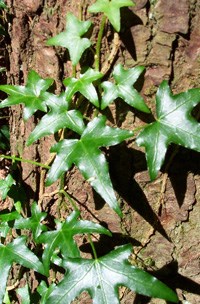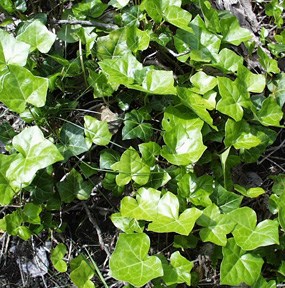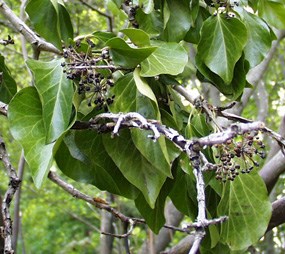
English ivy are five-lobed. NPS Exotic Plant Hedera helix Although some people enjoy the look of buildings covered with English ivy, this plant can actually harm structures by loosening bricks and native ecosystems by smothering trees. This evergreen climbing vine engulfs whatever is in its path, including shrubs, buildings, or old-growth forest. Identification: English ivy is an evergreen, creeping or climbing vine with aerial roots. It attaches to tree bark, walls, or other surfaces with its sticky roots. Old vines can grow as large as one foot in diameter, but most vines are usually much thinner. Leaves are leathery to waxy and dark green with pale or white markings. Usually the alternate leaves are three to five lobed, but leaves on mature sun-exposed stems can be un-lobed and rounded. Small autumn flowers become small black berries. It can take ten years to flower. The leaves and berries of English ivy are toxic to humans if ingested, but are eaten and spread by birds. 
nearly rounded five-pointed leaves. NPS Exotic Plant Management Team How is it spreading and where? English ivy is a cultivated European vine, originally from Eurasia and North Africa. It seeds are easily spread by birds. Its aerial roots climb onto native trees (or onto buildings) and can climb up to 35 feet or more. It can engulf anything it can climb over and smothers small plants or whole trees. Its most troublesome aspect is that it can grow in undisturbed ground and is shade tolerant. This means it can grow and thrive in even old-growth forest. It is found in various places in Olympic National Park, mostly coastal areas. 
and have leaves with smooth rounded edges. NPS Exotic Plant Management Team Control in Olympic: The easiest treatment of English ivy is hand-pulling. To help revive smothered trees, the strangling ivy vines are simply cut near the ground. While hand-pulling, the vine is followed back to its primary root and carefully removed completely. Herbicides are also used. For more information, see Weed Resources. Back to Invasive Plants |
Last updated: April 25, 2025
